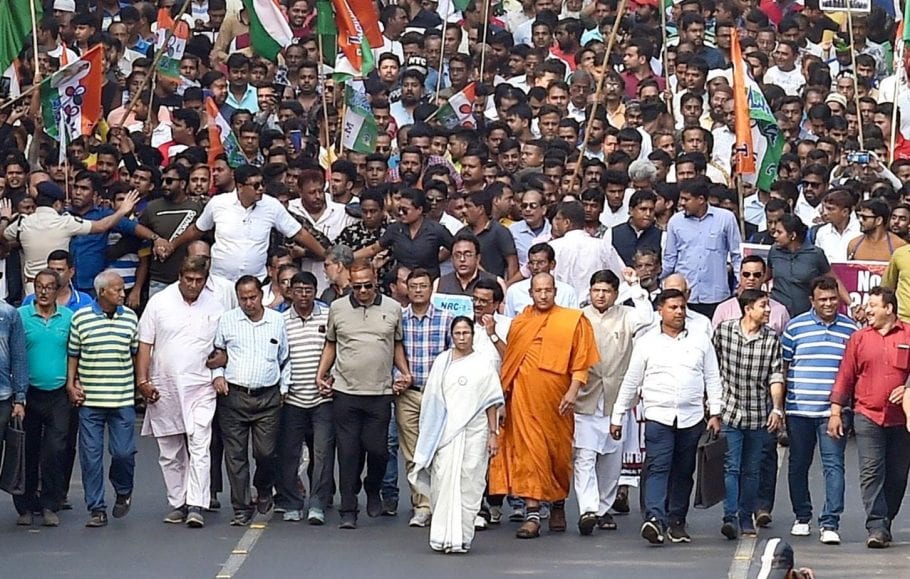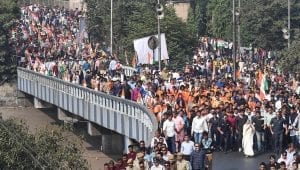
Anti-CAA protests transcend intra-community rivalry in Kolkata
Draped in a white saree with blue prints, the 77-year-old walked with multitudes led by Chief Minister Mamata Banerjee on Monday (December 16) from Ambedkar statue at Red Road, in the heart of the city, to Jorasanko Thakur Bari, the residence of Nobel laureate Rabindranath Tagore in north Kolkata, around 4 km away.

Septuagenarian Shanti Chakraborty has unwittingly emerged as a metaphoric messenger of the mass movement taking shape in West Bengal against the “two-pronged threats” of the Citizenship (Amendment) Act, 2019 and the proposed nationwide National Register of Citizens (NRC).
Draped in a white saree with blue prints, the 77-year-old walked with multitudes led by Chief Minister Mamata Banerjee on Monday (December 16) from Ambedkar statue at Red Road, in the heart of the city, to Jorasanko Thakur Bari, the residence of Nobel laureate Rabindranath Tagore in north Kolkata, around 4 km away.
It’s however not her frail frame or age that made her presence in the protest so paradigmatic. It is her other identity as Mohun Baganer Didima (the maternal grandmother of the historic Mohun Bagan Athletic Club) made her presence so symbolic and exemplary.

For the uninitiated, it is worth mentioning that an over 100-year-old rivalry between Kolkata’s two premier football clubs, Mohun Bagan and East Bengal has a root in Bengali’s juxtaposed identity as “Ghoti” and “Bangal.”
A “Ghoti” is a linguistic categorisation for those Bengalis with ancestral root in West Bengal. In the football arena they identify themselves with the Mohun Bagan. Likewise, ‘Bangals’ are those Bengalis who originated in erstwhile East Bengal or modern-day Bangladesh. Naturally, they swear by the club named after the ancestral home of their forefathers.
Chakraborty said despite being a “Ghoti” she walked in the protest march to send across the message: Eta sudhu udbastuder ba ekti bishesh somprodayer lodai noi. Ami sorik hoyechi apamor bangali bachonor lodaiye (It is not the battle to be fought only by migrants or a particular community. I have taken part in the march to fight to protect a greater inclusive Bengali identity).
Also read | Where is the Bengal, which once swore by non-violence to decry injustice?
“Jara opar theke eschen, ba jara eparer basinda, ebong bochorer por bochor ekhane achen, sudhu proyojonio nothi na thakle tara desh-heen hoye jaben, eta ki dhoroner byabostha? (What kind of move is this that just because of the lack of requisite documents, those who have come from the other side of the border or for that matter even those who are from this part of the land will be declared stateless or refugees, despite living here for years),” the Boubazar resident added.
At 77, why she needed to prove her citizenship, she further asked, adding that the ongoing protests against the NRC and the CAA should not be mistaken as agitations of any particular political party, community, sect or identity. The message Shanti Chakraborty sent across four days ago resonated in spontaneous participation of thousands and thousands of people in the four protest programmes in the city on Thursday (December 19).
Presence of unprecedented crowd in the protest march called by the Congress, which is otherwise regarded as a spent political force in the state, buttresses Chakraborty’s observation that the protest against the central government’s controversial decisions is transcending identity divide.

A recurring theme of the wave of protests Kolkata has been witnessing since Monday is, “We will not allow anyone disturb the harmonious concurrence of our multi-layered intra-community identities.”
In Trinamool Congress’s rally in Rani Rashmoni Avenue on Thursday evening, the mystic minstrels sang: “Banglar Hindu, Muslim, Bauddha, Christian bhag hobe na (Bengal’s Hindus, Muslims, Buddhists and Christians will not be fragmented).”
“No CAA, No NRC. We are for united Bengal,” said Abhijit Dasgupta, who down shuttered his shop in central Kolkata on Thursday afternoon to take part in the Congress’s demonstration at Chittaranjan Avenue.
Also read | Provocative comments by leaders add to tension in Bengal
“I am not affiliated with any particular political party. In fact, in 2014, I voted for the BJP, believing Narendra Modi to be a mascot of development and progress. I wanted to be part of this protest and since the Congress is taking out the march from Chittaranjan Avenue, which is not far from my shop, I am going to take part in it,” he said.
People from various walks of life, including actor-director Aparna Sen and theatre personality Kaushik Sen, took part in a protest march on Thursday afternoon organised by a joint platform of 60 organisations from near Moulali’s Ramlila Maidan to New Market.
“Till secularism, which binds our country, is re-established, protests will continue,” Aparna Sen said. She also condemned the detention of historian Ramchandra Guha by Bengaluru police on Thursday.
Seventeen Left parties and organisations and several student outfits too held protests in various parts of the city throughout the day, severely disrupting traffic movements.
The city of joy, however, happily braved the inconvenience for a “greater cause.”


